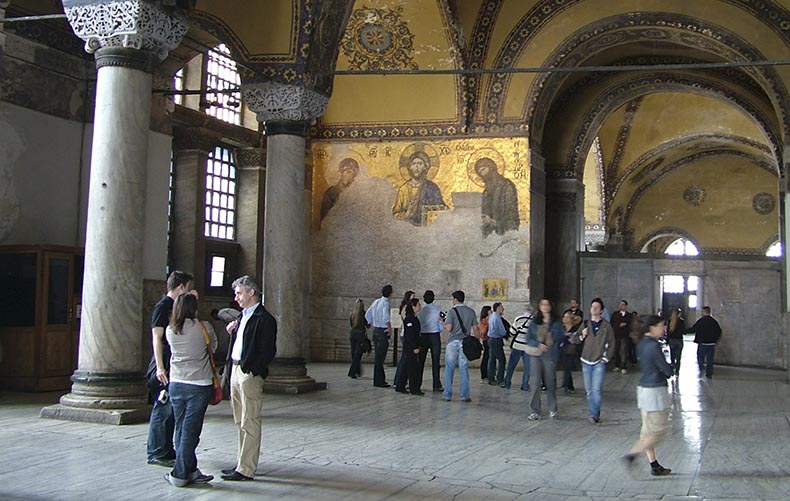
The South Gallery is most famous today because of the Deesis mosaic of Christ, the Theotokos and John the Baptist; and its Imperial portrait mosaics. The Deesis dates from the late 12th century, most likely from the reign of Manuel I Komnenos. The figures are twice life-sized and were uncovered in the late 1930's by Thomas Whittemore and the Byzantine Institute of America. This was made possible by the secularization of the then-mosque in 1935 by the first President of Turkey (1923-38), Kemal Ataturk, who invited the Institute to explore the building for the mosaics, which were then concealed under plaster and paint. On the right is the back of a large marble doorway which dates from the 6th century.
Below is a reconstruction I did of the South Gallery in the 12th century. There are some errors in the choice of the mosaics in the far vault. This would have been a Pentecost. Also the mosaics in the nearest arch are 6th century from Ravenna. The mosaics in this arch were originally decorative patterns. I could not find accurate images that would fit. The mosaic of Christ with the Cherubim and Seraphim with his bust in the middle is what was in this place until 1850. The image of Christ was facing the opposite way. When you were in the South gallery you were usually facing East. The reconstruction faces west. It is from the spot seen in the image below it showing the Imperial portrait panels.
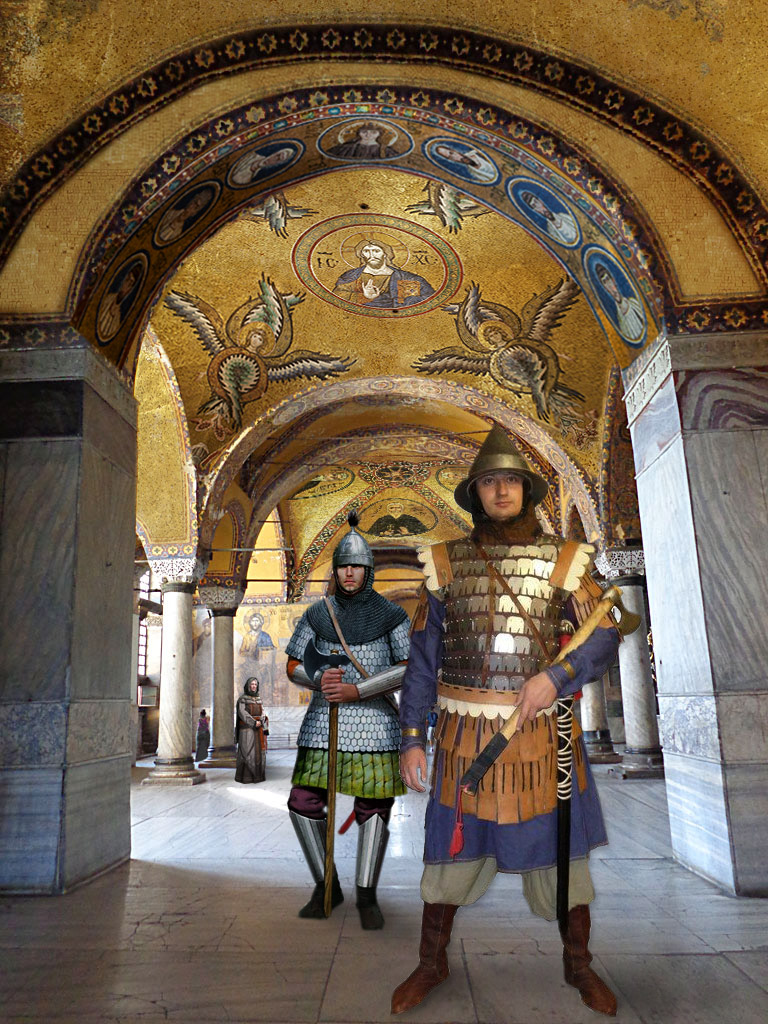
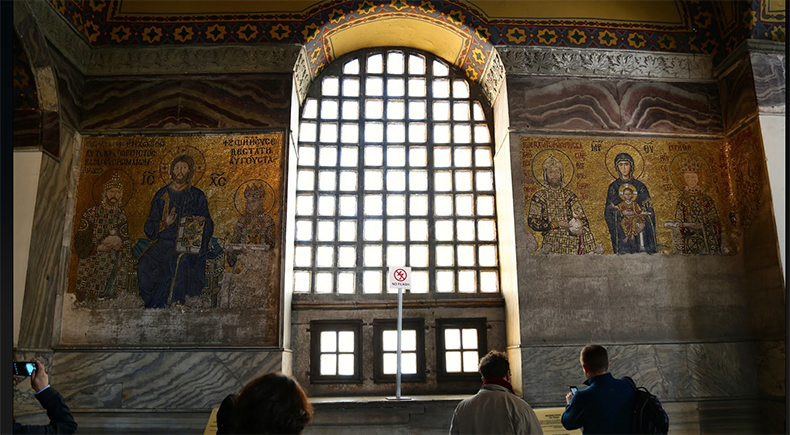
At the far eastern end of the South Gallery are two mosaic panels. The one on the left represents the Emperor Constantine IX Monomachos with Christ and his wife the Augusta Zoe. It dates from the 11th century. This panel was erected to commemorate two giant donations of gold to the church by two emperors who married the same princess. The mosaic panel on the right is of Emperor John II Comnenos, the Theotokos with Christ, his wife the Augusta Eirene - and around the corner on the pier - John and Eirene's son, Alexios, who was co-emperor with his father. That mosaic dates from the 12th century. The now vanished mosaics in the vaults faced west rather than east because the emperor and his family entered the gallery from a stairway outside the eastern wall of Hagia Sophia. They were greeted here at a special door by the patriarch and his cathedral clergy who escorted them, walking westward into the royal chapel which occupied the central bays of the South Gallery.
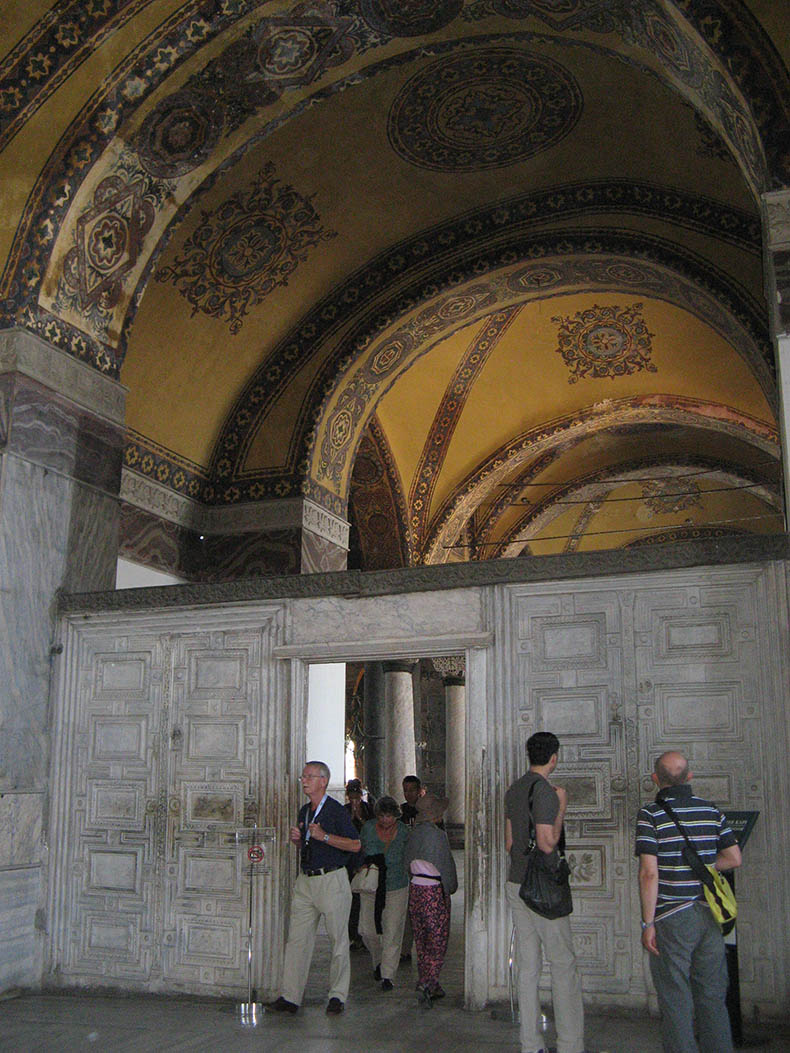
The marble door is made of Proconnesian marble and was made for this spot. It separates the area where church councils were held from the rest of the second floor. This is the front of the door facing west. They are panels carved with birds, foliage and decorative motifs, including a marble lock and key. Most of the panels are now effaced because they had Christian symbols. On the backside of the door are over-fife-sized crosses. These have also been partially erased. The door is extremely filthy due to so many people touching it with greasy hands. The Turkish museum authorities should place guards around Hagia Sophia it stop abuse like this.
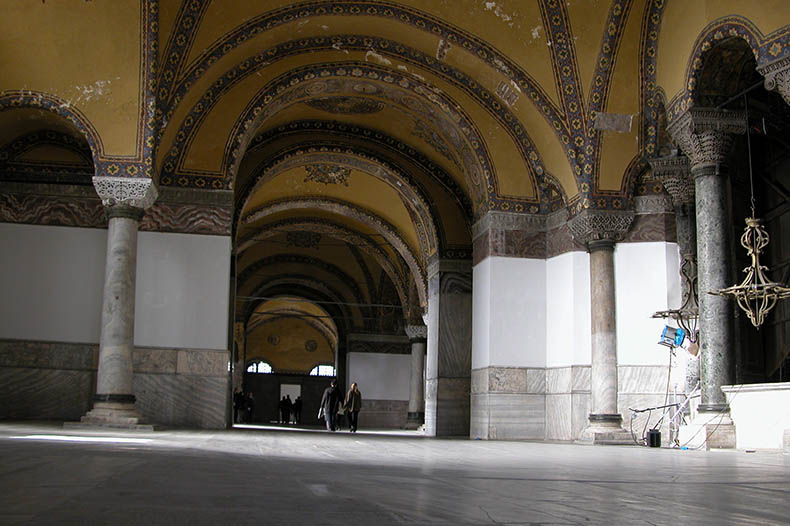
Here is a view looking west further back from the marble door, closer to the Imperial mosaic panels. Up until the late 19th century all of the vaults - and most of the wall panels - were covered in gold mosaics from Byzantine times. They are almost entirely lost. In 1907 guidebooks to the Aya Sofia mosque warned that the upper galleries were usually closed because of falling plaster and mosaics.
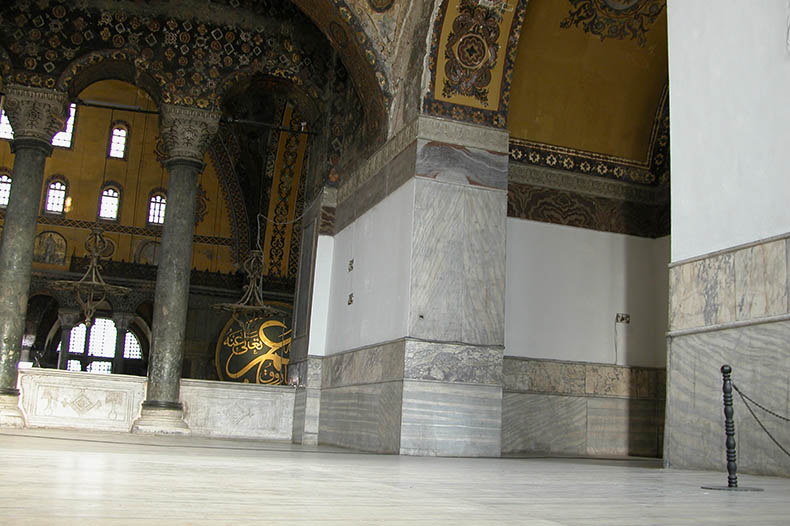
In the corner - in that bright spot - was most likely located a shrine to the Archangel Michael. The story was told that he had appeared here and promised to always protect Hagia Sophia from harm. This pier was a critical support for the whole building and having the promise of the Archangel would have been reassuring to the Byzantine visitors to the church. There are markings in the floor here that show the spot was a place of veneration. There would have been most likely, a mosaic of him on wall where you see the marks in the plaster. Since we don't know if this wall was covered by marble revetment or not, if it had it an icon of him mounted on the wall, too. The marble revetment in the galleries has been moved around a lot. It was also taken from here to replace damaged or missing marble else where in the church. You can learn more about marble revetment by clicking here.
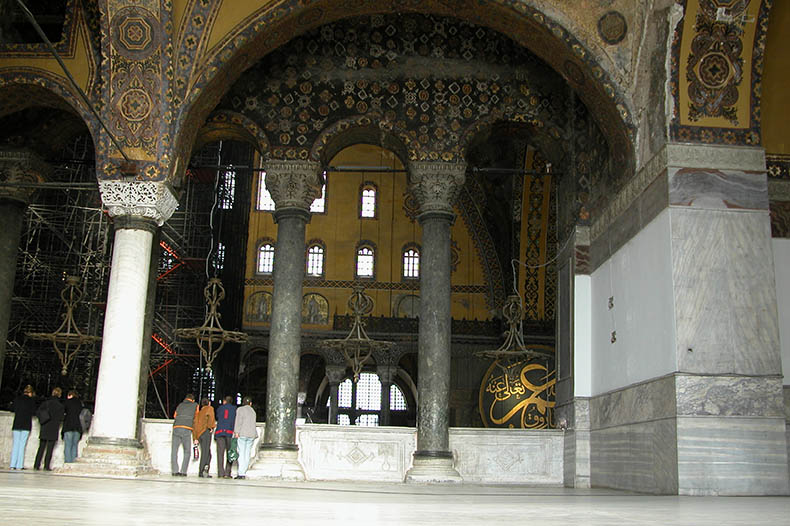
Here is a view moving west. You can see the carved marble panels placed between the columns. Each panel is 3.5 ft tall and has a rail set on top of it. The green columns are of Verde Antique marble from Larissa in Thessaly, Greece. There are two sized of them in the galleries 14 and 15 ft - used in the arcades and exhedra. The white columns and the capitals are made of white Proconnesian marble from the island of the same name in the Sea of Marmora. Marmora means marble and the island is 100 miles from Istanbul. From the 1st until the 7th century Proconnesian marble supplied the entire Roman world. It is an almost white large grained marble that has blue gray veining. It is a good for carving and is super easy to transport because the quarries are right on the sea. The quarries seized operation in the 7th century and were reopened in modern times.
On the south side of the area of the Imperial chapel is a closed door leading to a small chapel in one of the buttresses, which communicated with the Baptistery by means of staircases and passages. Perhaps this is the chapel of Saint Alexios which was said to be here. This chapel, which was rediscovered by the Fossatis, is supposed to be that into which, according to tradition, a Christian priest fled with the sacred elements when interrupted in his service by the entry of the Turks into the church. He is expected to issue from his hiding-place and resume his functions when the mosque again becomes a Christian sanctuary. This chapel, which has been the object of so much speculation, has recently been investigated thoroughly by Ken Dark and is described in his new book on Hagia Sophia.
The South Gallery was used for church councils and meetings. Most of the church synods in Hagia Sophia during the 11th and 12th centuries where held in the South Gallery, all four between 1019 and 1066, and 25 of 40 between 1066 and 1140. When the emperor made his distribution of the annual salary to the deacons and clergy of Hagia Sophia it took place here. In the center of this arcade (to the left, out of view) the patriarch would appear to bless the people in the nave below. The gallery connected to the patriarchal palace, which was on the south side of the church. The South Gallery was also connected to the Great Palace via a long passageway and staircase that was used by Imperial family to enter the church without having to pass through the narthex and nave.
Among the thousands of graffiti inscriptions in Hagia Sophia there are two of note in the South Gallery to mention that were left by bored attendants of church meetings here. Both are in Slavonic. One is on a column in front and to the left of the great marble door.its on the column that has been built into the pier. It dates from 1432 and says, "Lord, help Thy servant James, son of Gregory, scribe of Gerasimos, metropolitan of Kiev". The second one was left by a servant named Philip of another metropolitan of Kiev, Cyprian, probably in 1387 (he made three trips to Constantinople, so it could have been any one of them) which reads "Lord help thy slave Philip, Mikita's son, panter of Cyprian, metropolitan of Kiev and all Russia".
Another funny inscription in the South Gallery from the 13th century says " Ivan the fugitive wrote this".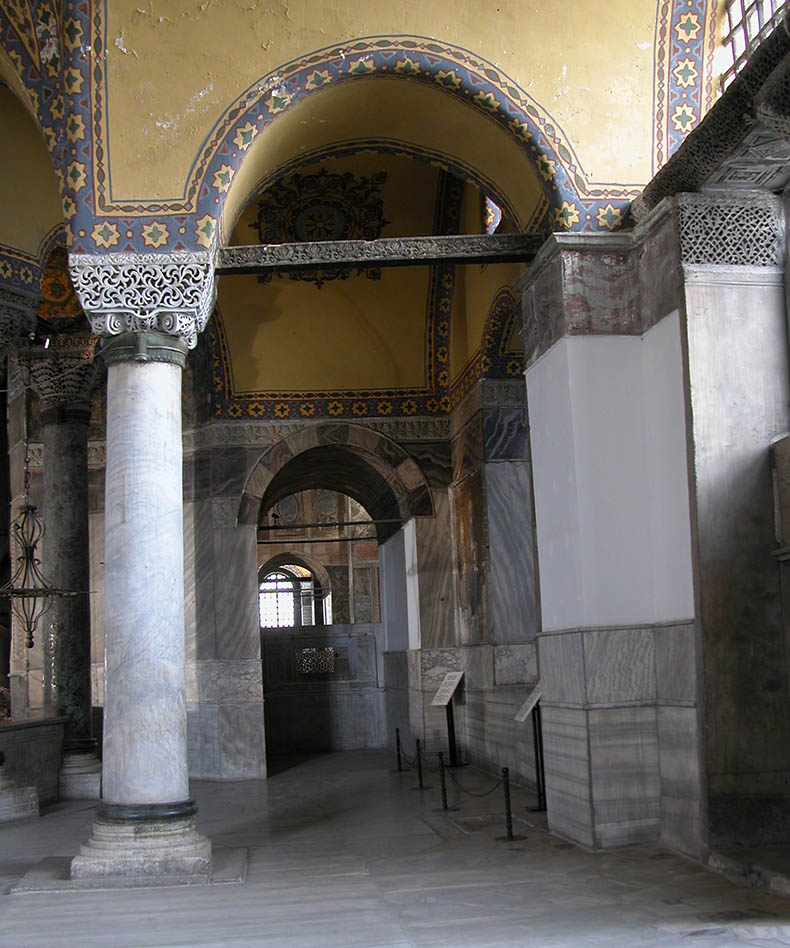
This passage is in the far east of the south gallery. It is right next to the Imperial mosaic panels and overlooks the apse. From here there is an excellent view of the Archangel Gabriel on the bema pier. The bottom revetment panels - next to the floor - are Proconnesian. The panels above them, with red veining and black veining running across the center of the picture are Dokimeion Pavonazzetto marble, from Iscehisar (Synnada), in Afyonkarahisar, Turkey. The Dokimeion quarries were under Imperial control so it is no surprise that large quantities and a variety of colors and veining patterns of this fine polychrome marble were used in Hagia Sophia. All of these vaults were covered with gold mosaic that has now vanished.
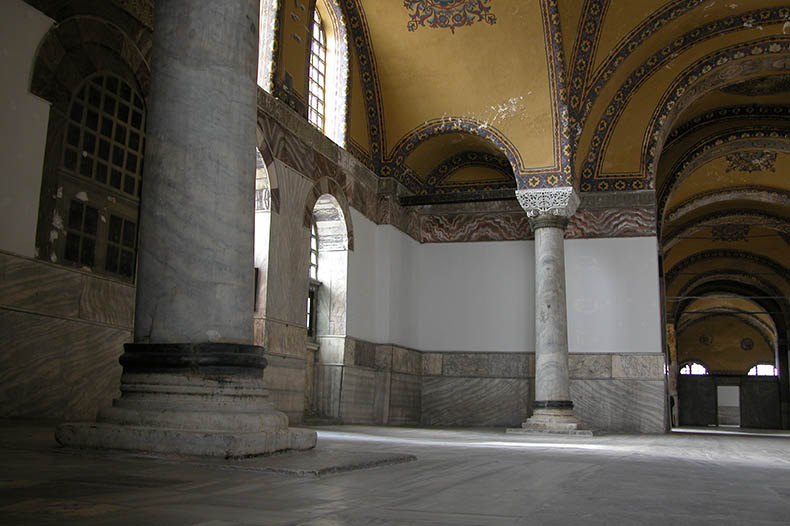
Above the plaster panels you can see a red wavy frieze. This is a painted imitation of cippolino rosso marble. Originally a frieze of this marble extended all around the galleries. Cipollino rosso, also called Carian or Iasos marble, comes from Kiyi Kislacik, Milas, Mugla, Turkey. Most of this marble has vanished and has been replaced with paint. It's interesting that the marble frieze was taken down - along with the plaster leaf frieze above it - to make more room for the Deesis mosaic.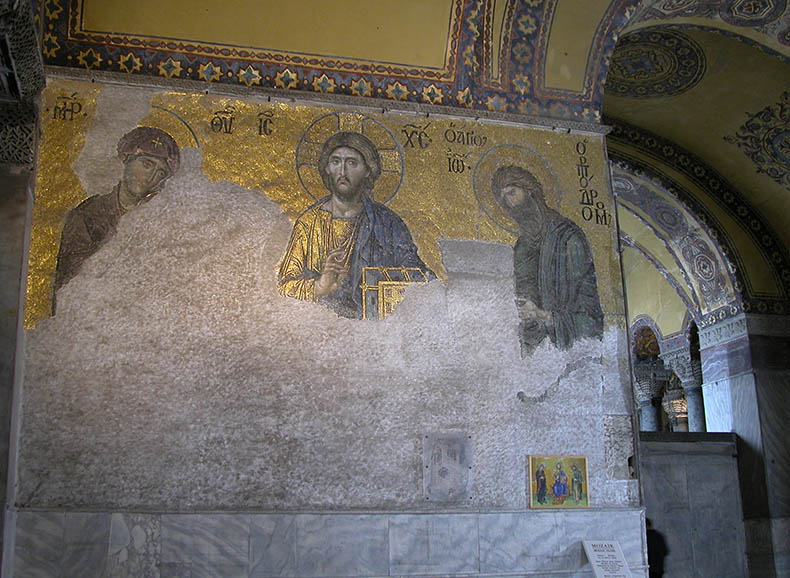
The mosaic originally extended down past the first level of marble revetment. One can see how the mosaic was designed specifically for this place. The raking light from the window to the left shows off the pattern in the background..The background gold pattern contrasts with the flat gold used in Christ's tunic. His halo is also laid in two different patterns. The cross arms are set in parallel lines and at an angle to catch and reflect light. The figures are two times life-sized. Unfortunately half of the figure of John the Baptist was lost when a sounding was carelessly made into the pier here in the 20th century.
There was an Imperial chapel in the South Gallery. The emperor would light candles and then stand in this chapel and participate in the liturgy then being conducted in the sanctuary. Holy Communion was brought to him here. The chapel was either associated with the Deesis mosaic in this bay of the gallery; or it was under the mosaic of John, Eirene and the Theotokos at the far eastern end. There are markings in the floor that show there where shrines in both places. There was a great candle stand in front of the Deesis.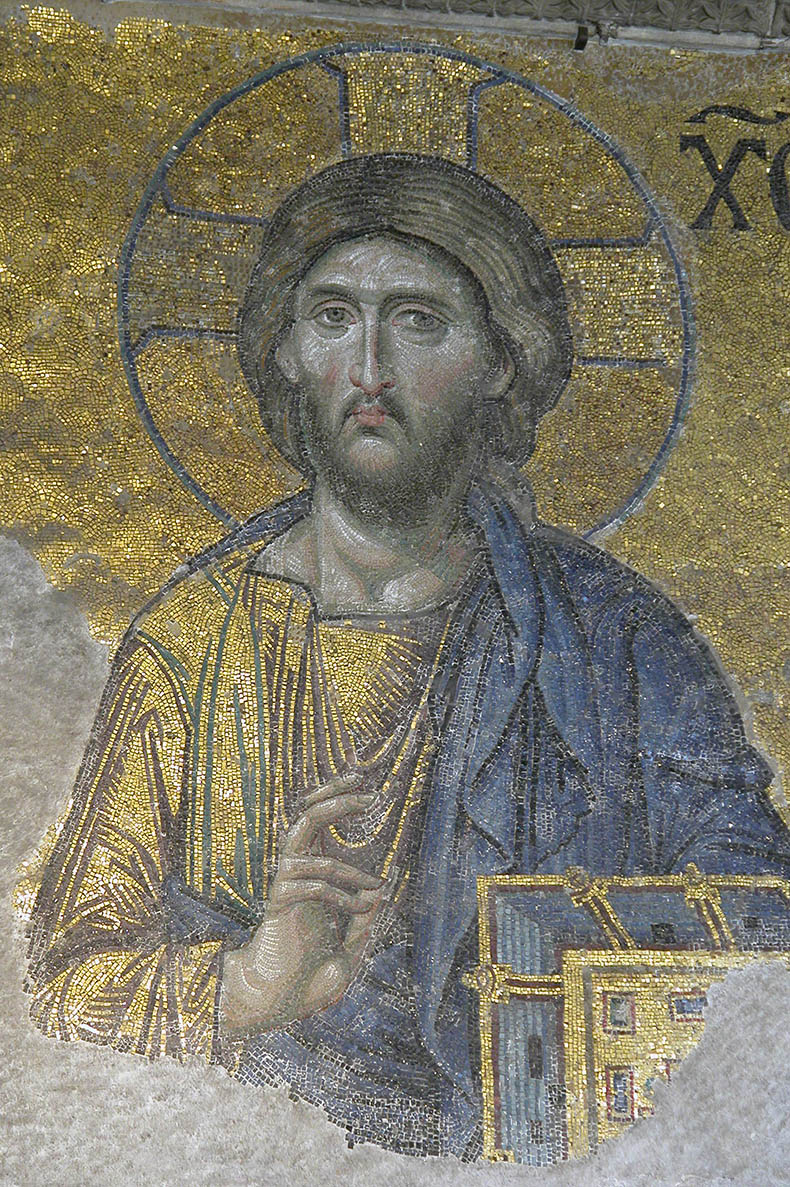
The figure uses a lot of gray in its modelling of flesh. This picture, taken in natural light, shows how the white highlights really pop. The face is 5 ft tall and uses an amazing range of glass and stone mosaic cubes. The rosy tones are subtly done. Some of them - especially in the beard are as small as a an individual strand of real hair.
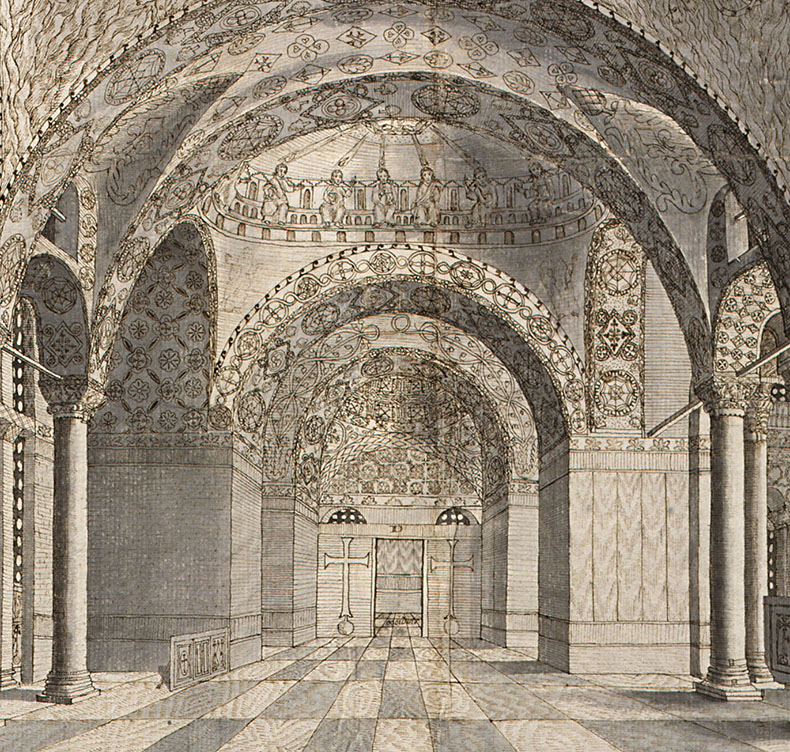
This drawing by the Swedish engineer Cornelius Loos is from the 18th century when Hagia Sophia was a mosque. It shows the mosaics of the vaults which survived until the late 19th century. The center vault is a depiction of Pentecost. The Deesis was covered up at that point. You can see a marble barrier with crosses to the right of the spot were the Deesis is. You can also see the center marble doors, nothing was damaged when Loos drew it. Learn more about the lost mosaics by clicking here.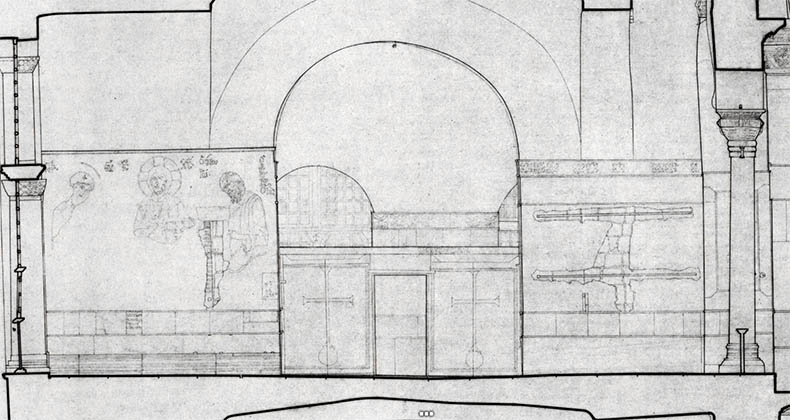
Here is a cross section drawing by Robert Van Nice of this same area. You can see where the figure of John the Baptist was damaged in the 20th century. Compare this to Loos and you can see how Loos regularized the curves of the arches and vaults. Robert maps every flaw and detail! You can view a selection of Van Nice drawings by clicking here.
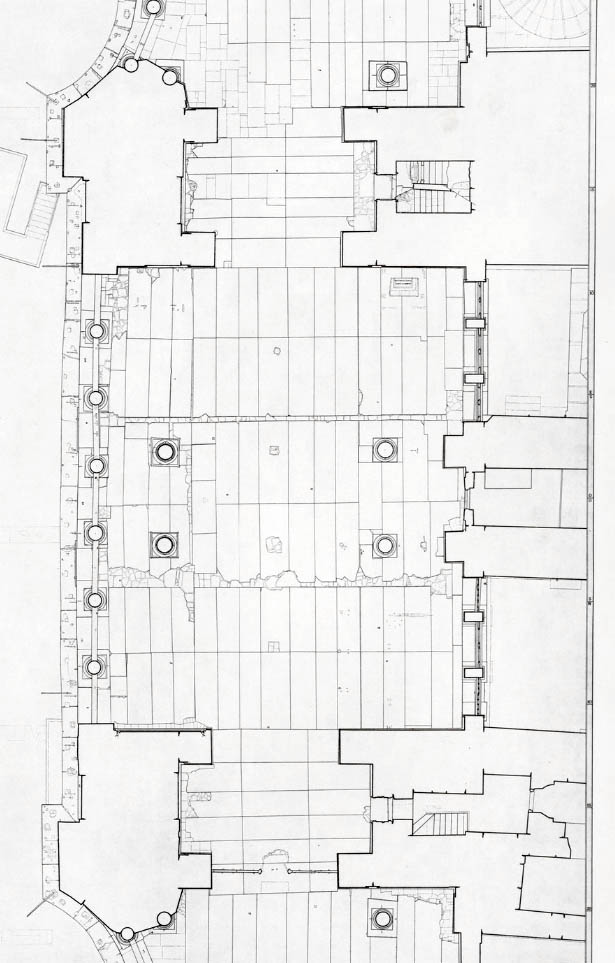
Above you can see Robert Van Nice's drawing of the central part of the South Gallery which shows every detail including damage and repairs made since the 6th century. You can take this map with you - they are on the DOAKs website - and check everything at your feet as you walk through it. Each one of the marble floor panels are around 6 ft long and most are from the 6th century. On the right, against the far wall you can see where the throne of the patriarch stood. The tombstone of Enrico Dandalo, the blind doge of Venice who took Constantinople in 1204 and died here in 1205, was moved to this spot in the middle of the 19th century as a curiosity. Catholic Latin clergy controlled Hagia Sophia from 1204 -1261.
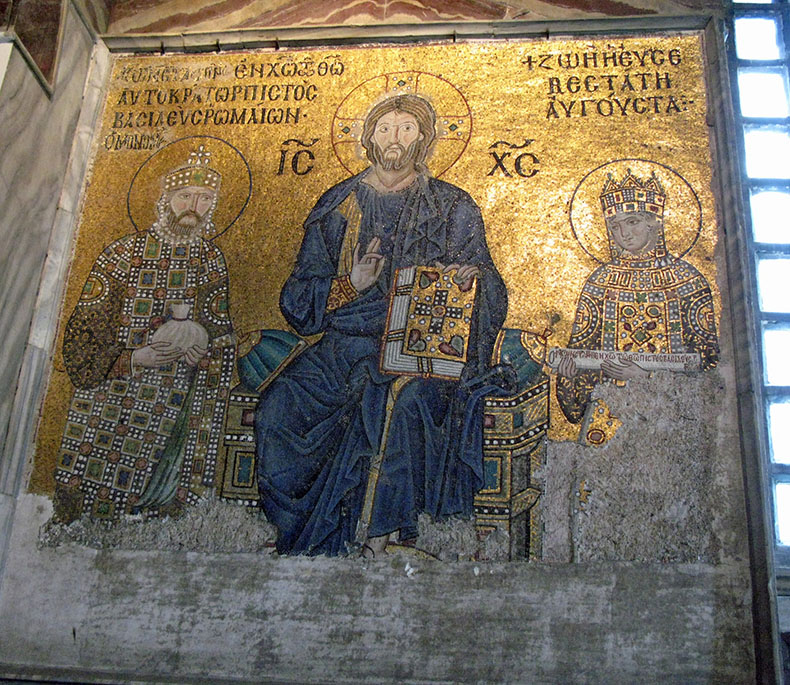
This mosaic shows Emperor Constantine and the Empress-August Zoe. You learn more about by clicking here.
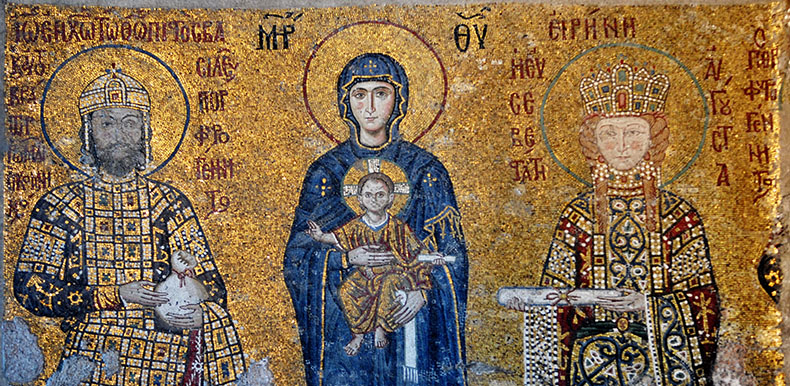
This 12th century mosaic shows Emperor John II Comnenos and his wife the Empress-Augusta Eirene. In the center is an image of the Theotokos holding Christ. To the right of this mosaic is a door to a famous spiral staircase (now vanished) that allowed the emperor and his family to move from the gallery to the nave that was used constantly. The staircase was attached to an elevated passageway that lead all the way to the Great Palace via the Chalki Gate. You can learn more the mosaic and the passageway by clicking here.
Below is an image of the Imperial Door to the South Gallery. Now this door opens out into space. The wooden staircase was attached to this door. Tomas Thomov has provided me with this image. It shows the lcation of graphi of a blessing hand. This area was covered with graffiti. The mosaic of John II and Eirene is to the left. She how the floor is messed up. This indicates the amount of traffic that went through the door.
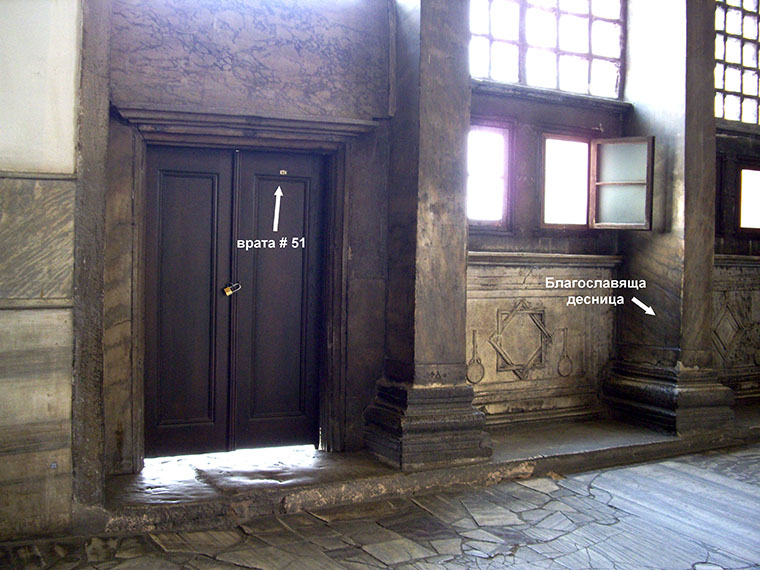
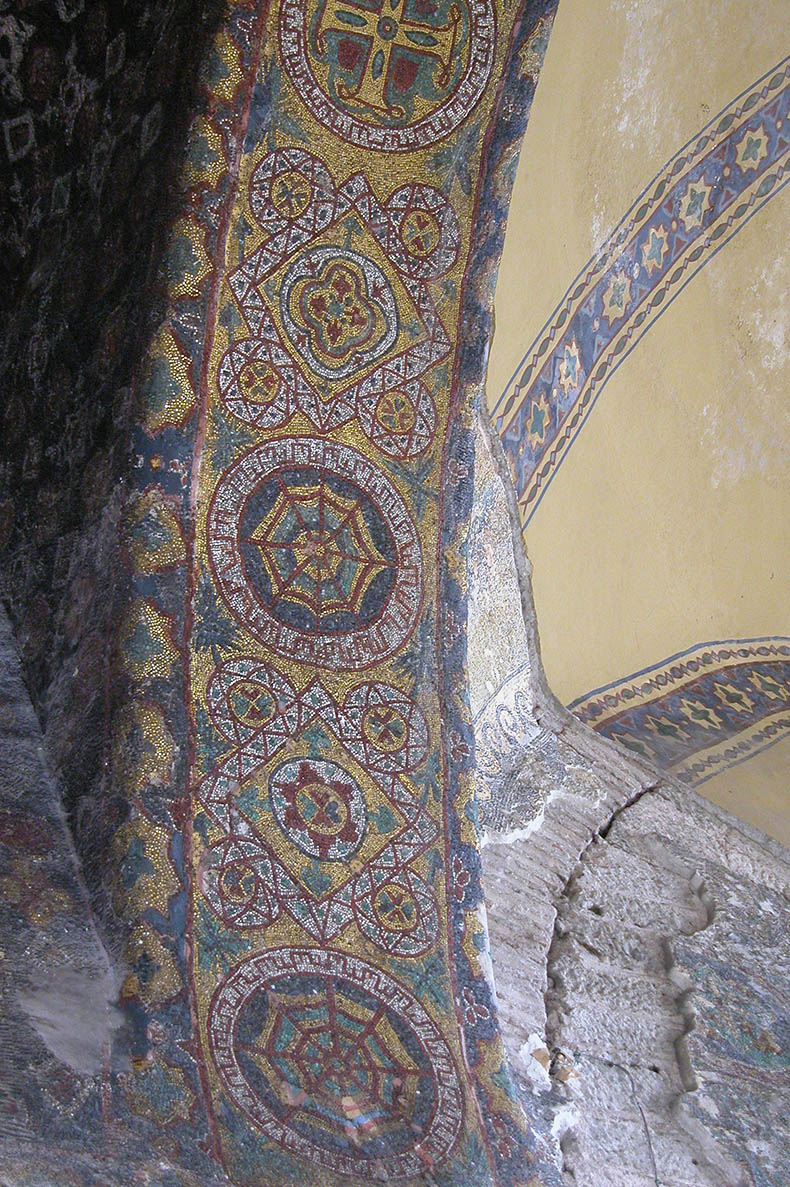
The image above shows original 6th century decorative mosaic in the South Gallery. All of the original mosaic from the time of Justinian was either decorative or simple crosses. There were no figures in them.
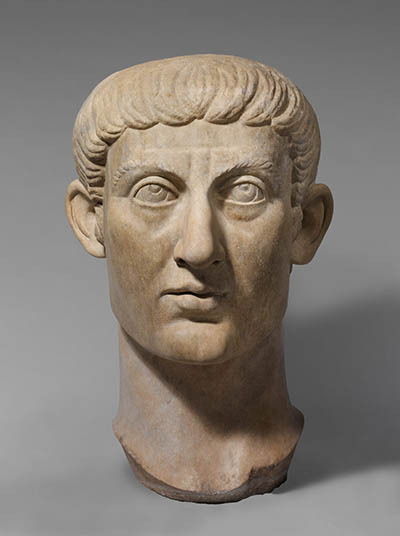 This marble head of Constantine is big - 37 inches tall and weighs more than 1100 lbs. We don't know hat kind of marble it is carved in, but it looks mass-produced in middle-grade stone. It was probably from a mass order for heads to be inserted into over-life-sized statues. It would have been easier to ship the heads from a central workshop around the empire. There would have been many statues that could be found that could have the heads switched out. this was done all the time. Since the head was meant to be placed in another statue - most likely with drapery over the head, it was not necessary to finish the air.
This marble head of Constantine is big - 37 inches tall and weighs more than 1100 lbs. We don't know hat kind of marble it is carved in, but it looks mass-produced in middle-grade stone. It was probably from a mass order for heads to be inserted into over-life-sized statues. It would have been easier to ship the heads from a central workshop around the empire. There would have been many statues that could be found that could have the heads switched out. this was done all the time. Since the head was meant to be placed in another statue - most likely with drapery over the head, it was not necessary to finish the air.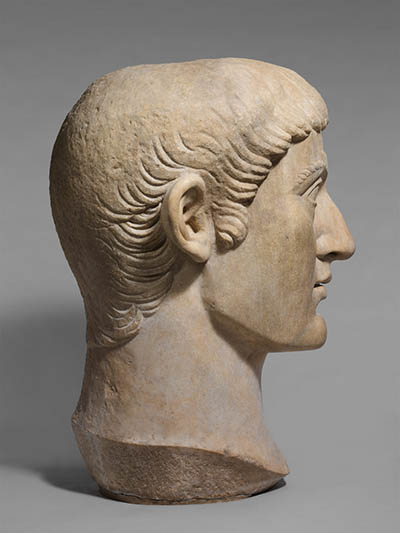 Wow, what a profile! The portrait head resembles Augustus. The mouth and chin are finely modeled. The resemblance to Augustus would have been intentional.
Wow, what a profile! The portrait head resembles Augustus. The mouth and chin are finely modeled. The resemblance to Augustus would have been intentional.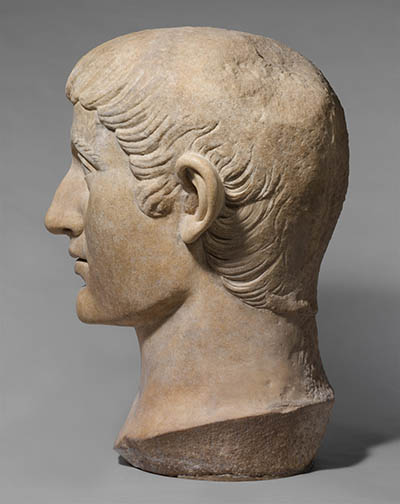 This bust has survived in an amazing condition. The nose is perfect.
This bust has survived in an amazing condition. The nose is perfect. This colossal bronze statue of Constantine is in the Capitoline Museum in Rome. A finger from this statue has recently been connected to the hand. The hand is below. The finger has been previously believed to be a toe from another, unknown, colossal bronze.
This colossal bronze statue of Constantine is in the Capitoline Museum in Rome. A finger from this statue has recently been connected to the hand. The hand is below. The finger has been previously believed to be a toe from another, unknown, colossal bronze.
.jpg)























 click here for icons of christ
click here for icons of christ click here for icons of the theotokos
click here for icons of the theotokos click here for icons of angels
click here for icons of angels click here for icons of saints
click here for icons of saints








